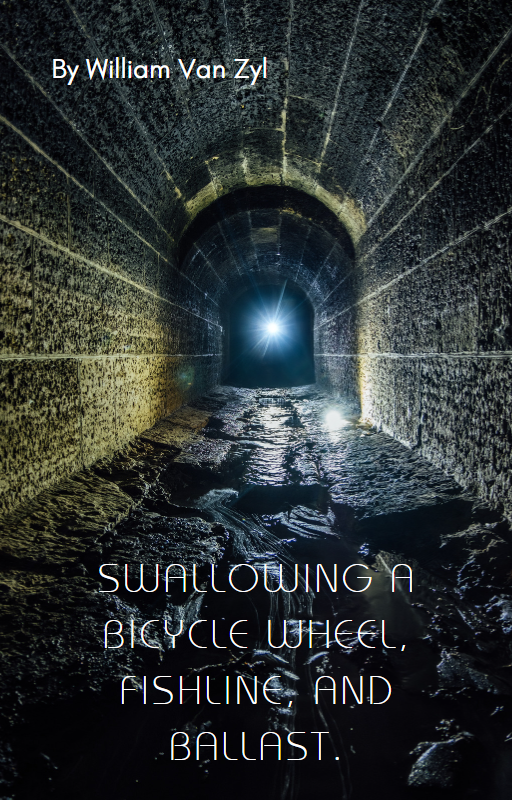
By William Van Zyl
Published on 20 May 2023

The heist of the century.

A stunning tunnel and a meticulously planned event – don’t miss this true story.
At 6:05 am, the two workmen in their high-vis vests were on duty in the street that runs past the Banco Rio in Buenos Aires. The lid of the maintenance hole situated in the road – on the side, out of the main traffic flow – was open. The round wrought iron lid – lying nervously still – looked at the still drowsy early-bird drivers passing by. The drivers showed no interest. One sewer worker was directing the traffic. A beanie with a giant fake moustache and safety glasses made him unrecognisable. His mate – lying flat on his tummy with his head and shoulders slumped into the manhole – was at work.
‘An early morning sewer inspection, I guess,” thought a passerby.
The man lying on the ground quickly pulled a small fishing reel from his top pocket and dropped a heavy lead ballast – taken from a model aeroplane – down the shaft of the manhole.
After about 2 seconds, he heard a Clank sound.
When the man felt the weight was on the bottom of the large sewer pipe, he carefully made a knot in the fishing line. He carefully aligned the knot with the mouth of the manhole. Then, he quickly reeled the weight in and returned the fishing reel to his overall pocket.
He thought the ‘professor’ would be impressed when he gave him the accurately measured distance on the fishline.
A cyclist slowly pushes his bike across the road at that exact moment. The man passes beside the workers and pushes his bicycle right up to the Bank wall. He then turns 90 degrees right. He stops. He gets on his bike and cycles away.
He recounted the valve rotations of the wheel in his head: One ….two……three….. and a quarter turn.
The cyclist was wearing a black coloured wig with a blue bicycle helmet strapped around his chin. He wore sunglasses and gloves.
He thought the ‘professor’ would be impressed when he gave him the measurements of the circumference of the bicycle wheel and the exact number of wheel rotations.
——————————–0—————————–
The sinister men were gathered around a large detailed map against the wall. They had a secret. They were collaborating in the soundproof intelligence room. They had been busy like little bees for a long time now. The map showed a sectional view of the Bank of Rio, the road next to it, the large sewer pipe that runs under it, and the three levels of the Banco Rio. The sketch included the basement, the ground floor, and the first floor.
“We have to enter from the Janitor’s room in the basement,” said the ‘engineer.’
They had some calculations to make- – accuracy and precision were required. They had a right-angled triangle to work with. They had the following data and measurements: Road to bank 6 meters, the distance from the manhole to the underground sewer pipe 15 meters. What would the length of the long side of the triangle be? They also needed an angle: The angle required to dig up from the large sewer pipe to the bank’s basement. They wanted the specific angle, direction, and distances to excavate their tunnel. It was a daring exercise; they had to be deadly accurate.
———————————0———————————-

The sectional drawing of the Banco Rio in Buenos Aires. In the sketch the bank is on the far right. The proposed tunnel runs from the bottom of the sewer pipe to the janitors room in the basement. In the middle of the sketch is the street adjacent to the bank (see the car in the street). The arrow in the middle shows the depth of the manhole (hidden behind the shoulder of the person in the picture). Credit: https://decider.com/2022/08/28/bank-robbers-the-last-great-heist-netflix-review/
——————————-0——————————-
Table of Contents
We all love a good story, right?
This story is an outstanding one, and valid. Why this story and the calculations, you may ask. I have a friend – a high school teacher researching how to embed Universal Design for Learning (in a Neurodiversity context) – who recently shared her planning with me. It immediately prompted me to think of the Banco Rio heist and the calculations for the tunnel to reach the bank. I include the context of the analyses in a neurodiversity scenario. Research shows that we all think differently – neurodiverse to be specific – and we all calculate and solve problems uniquely different. I have included sketches, a model of plasticine, and a model of the scenario in Minecraft education to illustrate possible ways to ‘view’ and ‘solve’ the problem. Some people need help when only given a description (text only). I am a visual learner. The first thing I do when encountering a problem like this one is to make a quick sketch or diagram. I could also consider making a quick model. We all use different methods and techniques to interpret and make sense of situations and scenarios. I am referring to diverse thinkers – those identified on the neurodiversity scale – which includes about 40 % of us.
Here is a challenging problem you could consider regarding tunnel digging.
Just for fun: Place yourself in the shoes of the robbers. Imagine you are deep down in the sewer tunnel – about 15 meters below the bank. While digging, you must keep a straight line from the sewer pipe position to the bank’s basement at the top (the janitor’s room). How will you do it? How will you keep direction and the correct angle while digging? It is easy to go off course. I have an answer at the very end for you. Please wait for it. Do you have a plan yet?
In short, what is Neurodiversity?
Simply put, this means that humans’ brains are wired differently, and those differences can directly impact an individual’s thinking and learning. These differences are often diagnosed as neurological conditions. Neurodiversity is an umbrella term that includes both life-long conditions and those that can develop throughout life. This has acquired illness or brain injury, Autism Spectrum Disorder (ASD), Attention Deficit Hyperactivity Disorder (ADHD), dyscalculia, dyslexia, dyspraxia, intellectual disability, mental health, and Tourette syndrome (The EducationHub, n.d., n.p.). See the link in the references to read more.
Statistics on Neurodiversity in New Zealand: ‘This is in keeping with international estimates that suggest around 15 to 20 per cent of the population are neurodivergent (Diversity Works NZ, 2022).’
In short, what is UDL (Universal Design for Learning)?

Source: https://edtech.cal.msu.edu/introduction-to-universal-design-for-learning-udl/
How to implement UDL?
One of the simplest ways to implement UDL is to offer multiple pathways to learning. This means providing students with different ways to access and understand the content. For example, give a visual representation of the content, an audio version, and a written transcript. As mentioned, I have included sketches of the tunnel to the bank, a plasticine model, and a Minecraft model to make the problem more visual.
Back to the tunnel problem:
The problem or challenge, in short: The robbers had to calculate the angle they had to dig. See the sectional views for details below for more information. The robbers used a bicycle on the surface to measure the distance from the manhole in the road to the bank (6 meters). They had to calculate the circumference of the bicycle wheel. Then they dropped a plumb line down the manhole – posing as workers – to measure the depth. They had the 2 sides of a right-angled triangle. But what was the length of the long side of the triangle (the length of the new tunnel)? What was the angle they had to follow? They could not afford to miss the bank basement as they were digging.
PLEASE NOTE THAT THE MEASUREMENTS I HAVE USED IN MY SKETCHES AND MODELS ARE VERY CLOSE TO THE ACTUAL MEASUREMENTS. I DON’T HAVE THE EXACT MEASUREMENTS (rounded off to the nearest meter).
I pose the problem with easy-to-use measurements (a right-angled triangle). However, the angle of the tunnel – from the ground upwards – was about 68 degrees – according to my research.

Modelling the problem and the solution with plasticine (modelling clay – very cost-effective). Working out the new tunnel’s angle and length (long side of the right-angled triangle). You are familiar with the basic formulas and calculations – if not, use online calculators – easy as pie to use. However, look at the modelling – consider how 3-D modelling could be used to assist students in understanding the problem and solution.
Online calculators:
In 2006 online calculators – compared to the ones available today – were less sophisticated and user-friendly. I have included screenshots of online tools to make calculations easier (available in 2023).
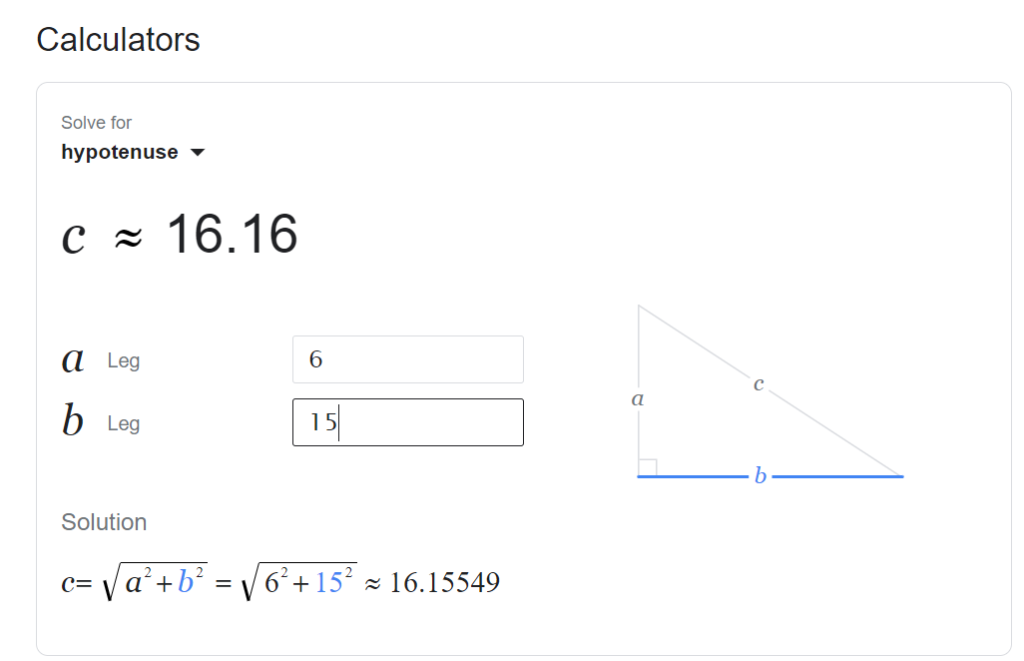
Search ‘online calculator hypotenuse.5’ Several ones are available. Source: https://www.omnicalculator.com/math/hypotenuse

Source: https://www.omnicalculator.com/math/hypotenuse
Practical tools and modelling to solve the tunnel calculation problem:

Measuring the diameter of the wheel of the mountain bike. I used the well-known formula to calculate the circumference of a circle (the mountain bike wheel). Shown in the picture is my mountain bike with a tape measure.

Sketch – ink (fountain pen) and watercolours of the newly proposed tunnel. Credit: Author.
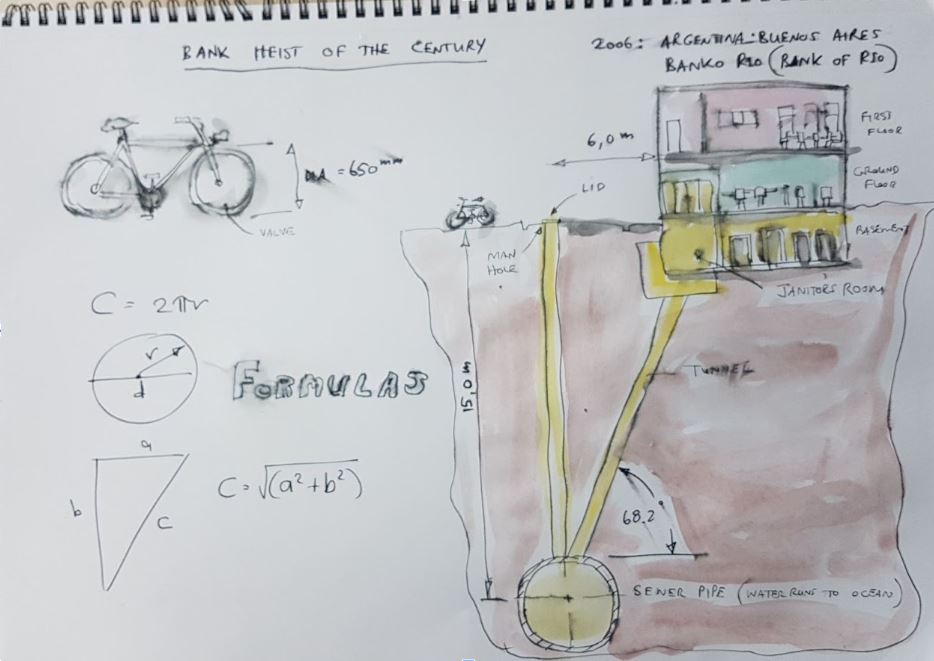
Quick Sketch: Sectional view of the tunnel and the bank. Formulas far left and the bicycle is shown in the middle on the road. Credit: Author.
Over the years, I have developed my knowledge of Minecraft and the use thereof in lessons. It could be of value to you when endeavouring to solve complex problems. I have discovered how versatile investigating and communicating issues and solutions can be.
In this article, I have used sketches, modelling clay, and Minecraft Education to improve my understanding of complex ideas: It made my understanding easier on calculating the distance and angle of a right-angled triangle (in a real-life context). I have also illustrated these tools so students, parents and teachers can use them to communicate and express their thinking when posing and solving problems. The focus is on improving and developing UDL. Minecraft is a powerful tool. Students love to use Minecraft for all different subject applications, including primary school students and teenagers up to 17 years old. Some adults are also dead keen on playing Minecraft! So much fun when collaborating and playing in teams.
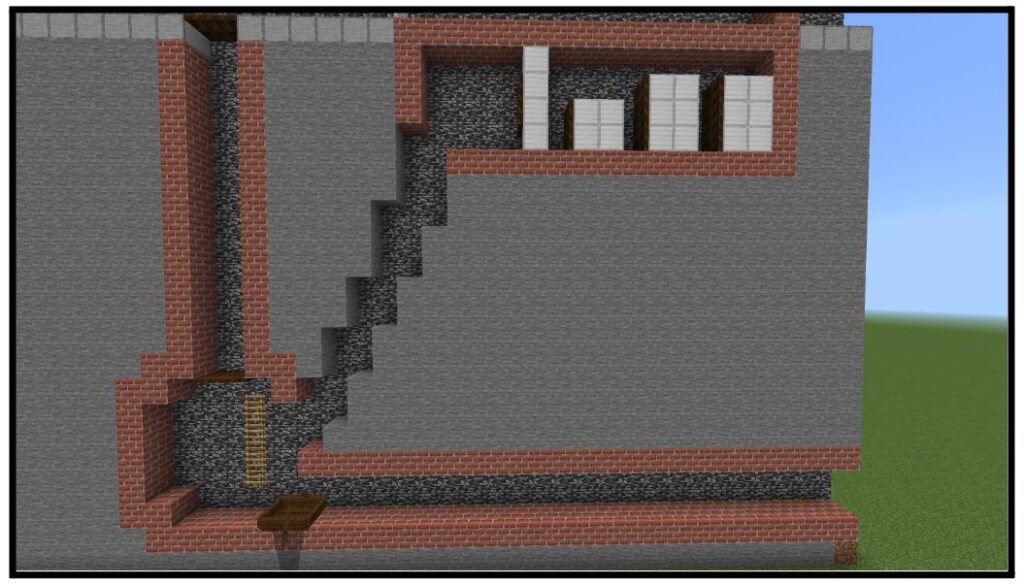
Image: Students have used Minecraft to model the bank, the sewer pipe, and the new tunnel. It took 3 students about 20 minutes to think about the problem and to model the sectional view. Modelling and communicating a problem and a solution in 3-D is a great way to improve students’ understanding of problems and possible solutions. Excellent UDL principles to address neurodiversity.
What is the takeaway for you from this article?
Understanding neurodiversity and UDL when working with young children, teenagers, and adults. Develop your knowledge as a teacher, friend, parent, caregiver, and grandparent so your interaction – posing and solving problems – could be more descriptive and well-thought-through. Develop your communication and presentation skills! Remember, we all think differently.
Summary of the Bank heist in Argentina (Buenos Aires) in 2006. The planning took about 4 years!
The bank heist at the Banco Río branch in Buenos Aires was an audacious and highly publicised criminal incident. Referred to as the Heist of the Century.
The Banco Río heist involved a unique and meticulously planned method of entry known as “the tunnel.”
Here’s a short summary of the event:
In January 2006, a notorious gang executed an elaborate heist at the Banco Río branch in Buenos Aires. The crew, led by criminal mastermind Fernando Araujo, devised a detailed plan to dig a tunnel from a sewer pipe to the bank’s vault. They rented a property near the bank.
The tunnel, approximately 15 meters long and expertly constructed, took several months to dig. The gang members utilised professional mining tools to maintain secrecy and precision during the operation.
On the day of the heist, some gang members entered the bank through the front door and held some bank clients hostage on the first floor. While the robbery was underway, the police surrounded the bank, unaware of the tunnel’s existence. Negotiations were initiated with the criminals, but their demands remained unclear, likely due to the chaos and unpredictability of the situation. They continued to negotiate with the police – playing for time. At the same time, some of the other robbers entered the bank via the tunnel from the basement. They entered through a hole in the wall of the janitor’s room.
Once inside the bank’s vault, they turned off the security systems, rendering them ineffective. The gang meticulously broke into countless safety deposit boxes, stealing significant cash, Jewellery, and other valuables. They had created a unique tool to open the deposit boxes effortlessly.
During the heist, the robbers displayed knowledge about the bank’s layout and security measures, suggesting they had studied it for months. When they left – after some hours – they disappeared through the hole in the janitor’s wall. They neatly pulled the cupboard before the gap to delay the police. They left their ‘plastic’ guns at the tunnel entrance with a note to the police (unarmed robbery). Sign read: … it is just money!
After several hours, the police decided to storm the bank. However, the gang had fled through the tunnel by the time they entered the vault, leaving the hostages unharmed. The robbers escaped with rubber dinghies powered by petrol motors through the maze of sewer pipes under the city. They even installed a ‘dam wall’ to ensure that there would be enough water to float the dinghies. Cleverly they did not go out straight to the ocean – as police would have expected – but turned to the middle of the city. There they had a Volkswagen van waiting over a maintenance hole for them (a special opening was created in the van’s floor). See the picture of the van over the manhole in this article. They hoisted their booty – and themselves – quickly and efficiently into the Volkswagen. They took off without a hitch! Later, the police were baffled when they discovered all their audacious plans. The media blared out the news in every available newspaper and magazine.
Despite an extensive manhunt, the gang members disappeared. The stolen loot was estimated to be worth 8 million dollars plus 130 kg of Jewellery, making it one of the most significant bank robberies in Argentine history.
The Banco Río heist, with its intricate tunnel plan, captivated public attention due to its audacity and the level of sophistication displayed by the criminals. The event exposed vulnerabilities in bank security and led to increased scrutiny and reforms in the country’s banking industry.
The robbers were captured when one of the robber’s wives expected her husband was hanging out with a younger woman. She ensured he did not leave her and took off with the money and the younger woman. She knew all about the heist. She took revenge. She simply picked up the phone and dialled the police. Easy! What a contrast!
Since their release – serving on average 9 to 10 years for unarmed robbery – a documentary and a complete movie with interviews were created. A stunning story, don’t miss it! See details below.
The ‘tunnel heist’ was recently released as a documentary movie. The actual robbers tell their story in several interviews (Netflix).
Trailer:

https://www.imdb.com/video/vi3836460825/?playlistId=tt10948718&ref_=tt_ov_vi

The mastermind behind the 2006 Banco Rio heist in Argentina: The real Fernando Araujo. ‘The Artist.’ Credit: https://www.leisurebyte.com/bank-robbers-the-last-great-heist-whereabout/
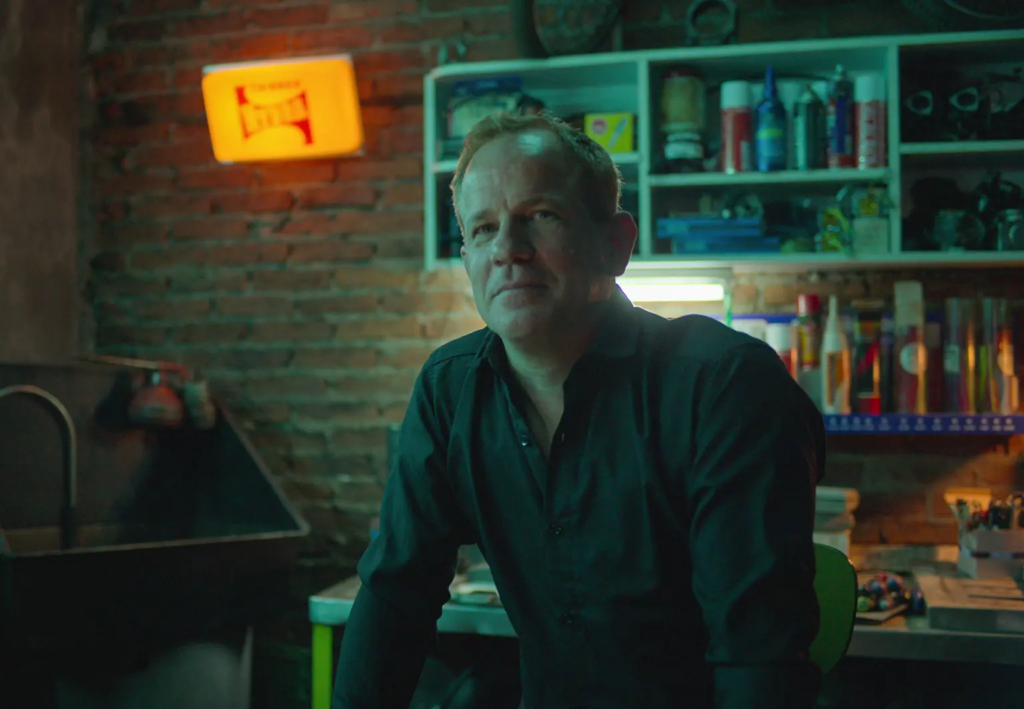
The real Sebastián García Bolster: The ‘engineer’ to the robbery. Credit: https://nypost.com/2022/08/10/how-a-thiefs-wife-ruined-the-heist-of-the-century/

A special opening with a hatch was created in the floor of the Volkswagen van. Here one of the robbers climbs up into the van after they had hoisted the loot into the get-away vehicle. Credit: https://nypost.com/2022/08/10/how-a-thiefs-wife-ruined-the-heist-of-the-century/
Answer to ‘how to keep the direction and correct angle while digging the tunnel’:
Chisel a small hole in the concrete of the sewer tunnel floor. Concrete a surveyor’s peg into the ground. Set up a theodolite (unique land surveyor tool – on a tripod) to throw a laser beam up at the right angle (68 degrees up) while digging. Set up the theodolite every day over the peg and adjust to the different angles which have been pre-calculated – align with the known horisontal and vertical angles. You will have to make permanent markings on the ground where the peg is cemented in position. For example, a compass rose – North, South, East and West to assist you with the main compass directions underground. By the way, an average theodolite costs about $ 2000. Fun fact: The team of robbers had an investor pouring $ 100,000 into the heist project. He was called the INVESTOR.

Typical theodolite. Credit: https://nedo.com/en/product/optische-instrumente/nedo-theodolite/
References:
Diversity Works NZ (2022). No Author identified. Link: https://diversityworksnz.org.nz/news-resources/news/neurodivergent-workers-overlooked-in-new-zealand/#:~:text=This%20is%20in%20keeping%20with,population%20are%20neurodivergent%2C%20Pete%20says.
The Education Hub (n.d.). What is Neurodiversity? (Website).
Copyright © 2023 by William Van Zyl
Swallowing a Bicycle Wheel, Fishline, and Ballast.
All rights reserved. This eBook/article or any portion
thereof may not be reproduced or used in any manner
without the publisher’s express written permission, except for using brief quotations in a book review.
Published by Five House Publishing (New Zealand)
First Publishing, May 2023

More eBooks and articles are available at https://fivehousepublishing.com/
More about the author at http://williamvanzyl.com/
Podcasts: https://williamvzyl.podbean.com/
Fascinating. I was supervising a high school maths class and one of the students challenged me about what practical use maths had ever been in my life. I told her about how I had designed the roof trusses for the house I built using basic trigonometry.
Thanks John. Making roof trusses are a perfect example of the use of Trigonometry. You are right. Maths skills – Trigonometry – are invaluable in life. There are so many applications! Thanks for sharing. Regards. William Van Zyl (Five House Publishing).